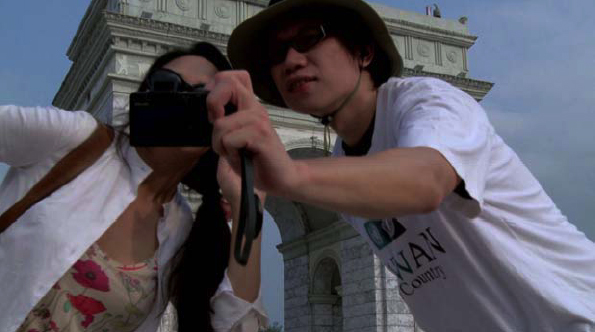The urban environment has, for some years now, been cheerily gobbling away at the fields and hedgerows and hillsides of the Irish countryside. In recent months, as the construction industry grinds to a halt, this rampant urbanisation is finally slowing to a polite chew. It feels like the right time to stop building and start thinking, to survey the spaces and consider the implications of all these taken-for-granted concrete, steel and tarmac features. The four video pieces that make up Invisible city at The Lab, despite their global flavour and the artists’ Taiwanese nationality, are distinctly apt in the context of contemporary Ireland.

Liverpool Top 9, presented by a man from SKY with a newsreader’s manner and gait, looks like one of those educational snippets that pop up between programmes on Channel 4. The title instantly suggests that there is something amiss, something suspicious at play. The presenter introduces us to nine unobvious or unknown ‘quirks’ of the city’s structural and social façade; from a line of metal posts designed for the training of show-dogs to roll-away pedestrian crossings. When he starts to demonstrate the new trend for ‘traffic-light dancing’ (when the green man starts going beepbeepbeepbeepbeepbeepbeepbeepbeep, don’t cross the road, clap your hands and kick your feet to the lively, albeit slightly repetitive tune), then the penny begins to drop. Commissioned for the 2006 Liverpool Biennial, Tsui Kuang-Yu readily admits that some of the Top 9 featured in the piece are invented. Yet the false ones could not have been imagined without the truly peculiar facilities and stories uncovered through engagement, exploration and research. Liverpool Top 9 elicited regular titters from the audience on opening night, but the humorous undertones do not mask the film’s careful construction and clever foundation.

Tsui does not really mind people laughing, so long as they are aware that the work comes from a position that is serious and even a little sad. Re-presented as part of Invisible city, Sea level leaker was made during a residency at the Rijksakademie in Amsterdam in 2006. This short but eye-catching piece follows Tsui as he traipses past the city’s most recognisable landmarks, all the while sporting a mackintosh and rain-proof trousers that shoot jets of water across his shoes and the surfaces that surround them. Passers-by stop to point and gawk at Tsui’s walking rain cloud as he tramps through the floating flower market, over the Magere bridge, up and down endless canal banks. The piece responds to the fact that the city of Amsterdam sits thirteen feet below sea level, something the locals probably don’t pay a second thought to. In a place as ethnically diverse as the Netherlands’ capital city, Sea level Leaker is a poignant reflection on the difficulties faced by newcomers in a foreign land. Amstel 88 III is a much shorter piece that derives from the same theme. Inside his Dutch bedroom, Tsui cannot remove a picture from the wall or open a drawer without the ocean rushing in. It squirts him in the face and soaks his shirt, an unstoppable reminder of how far from home and out-of-place he is.

Tsui describes Taiwan, like the Netherlands, as “a country that melds different cultures." A small island off the coast of China, Taiwan will only sound familiar to many people in Europe from the stamp on the underside of plastic toys we owned as children. For the most recent film-work on show in The Lab, Tsui has shifted the focus back to his home country. A series of short clips all begin in close-up; what appear to be an amorous couple or a sun-seeking tourist are back-dropped by the Statue of Liberty or the Arc de Triomphe. But as the camera steadily moves outwards, the scene is revealed as a fake. The couple are just waiters in a Taiwanese café and the tourist is a local man trimming hedges. Entitled Taiparis York, the clips satirise and subvert miniature imitations of famous landmarks that have appeared as public sculpture in cities throughout Taiwan. It is momentarily strange to hear Tsui describing these pseudo scenes of the Western world as depictions of “people seeking for exoticism," when Taiwan seems so much more glamorous and mysterious than the drizzly depths of an Irish Spring. But the piece is essentially about the same dreams of escapism that we all share, wherever we are and whatever we have.

Taiparis York reminds me of something Kafka wrote: “You need not leave your room. Remain sitting at your table and listen. You need not to even listen. Just wait. Be quiet and still. The world will freely offer itself to you to be unmasked. It will roll in ecstasy at your feet." Kafka could not have known how true this would become in the twenty-first century, could not have imagined the limitlessness of the World Wide Web, how humdrum and everyday the practice of Googling. The New York skyline can twinkle on your computer screen as surely as the Eiffel Tower can sit in the middle of an office complex in Taiwan. In a landscape and a society that is becoming increasingly globalised, Tsui demonstrates an eye for detecting aspects of individuality and a knack for refreshing the quirks and irregularities that make each place what it is.
Scratching beneath the surface for the artistic potential of Ireland’s stalled structural economy, Tsui will remain in Dublin until the end of April, based in a studio in the Red Stables as part of The Lab’s residency programme.
Sara Baume